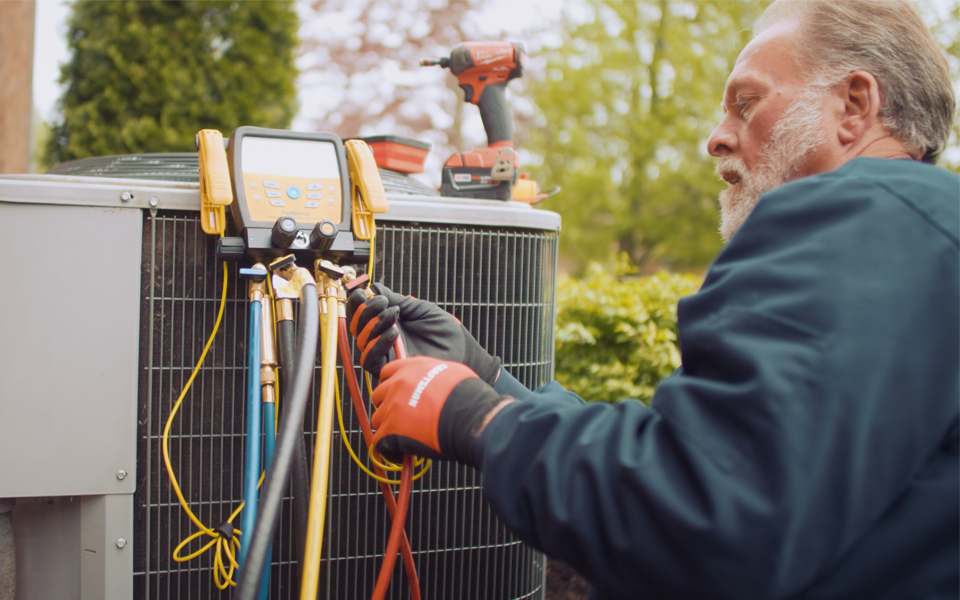*On June 1, 2023 Emerson’s Climate Technologies business became a new standalone company – Copeland. Though our name has changed, we are building on more than a century of HVACR innovation and industry leadership, and Copeland continues to offer the same products, industry stewardship, and learning opportunities you’ve grown to trust. Information found on this webpage posted before June 1, 2023 may contain our old name or branding, but you can be at ease knowing it was created with the knowledge and expertise of Copeland.
There was much handwringing in the world of HVACR over the Department of Energy’s (DOE) latest regulations and requirements for efficiency and refrigerants in air conditioning and heat pumps. This is understandable, as these changes come with a number of significant complexities that can alter the daily operations for professionals in all corners of the HVAC world.
On the refrigeration side of the industry, much of these changes revolve around carbon emissions from hydrofluorocarbon (HFC) refrigerants and their potential contribution to climate change. As policies aim to mitigate the use of HFCs, the industry has seen a shift toward alternative refrigerants with lower global warming potential (GWP). However, some of the newer, more environmentally friendly refrigerants require system changes to ensure maintaining performance and compliance with new safety standards, as some of these alternatives carry the risk of flammability and others may require higher system pressures to be maintained. Ensuring the safe use of these new refrigerants will also require more education and engagement between HVAC professionals and OEMs.

As far as changes to efficiency requirements, all regions throughout the U.S. are seeing increases of one Seasonal Energy Efficiency Rating (SEER), which will result in a lower amount of electricity used for the same amount of cooling. These changes are made to better reflect changing field conditions, such as new HVAC technologies and longer duct runs used in home building. In addition to these changes, the DOE is also implementing new procedures for calculating efficiency which will lead to new metrics to represent seasonal efficiency, full load efficiency and seasonal heating performance.
Gauging Awareness and Preparedness with Contractors and Wholesalers
Incrementally through our surveys leading up to the 2023 mandate, results showed that most industry professionals, especially in the South, took necessary actions to adapt their businesses to these changes by engaging with OEMs, attending product seminars and utilizing other educational resources. Since Emerson began surveying HVAC professionals on the topic, there was a consistent increase in the amount of overall awareness of these changes. According to the survey, most respondents (91%) were aware of the upcoming regulatory changes, and the majority had at least a basic understanding of requirements (61%). An even more optimistic finding was that there was a sizable increase in the number of industry professionals who said they have an extensive understanding of these regulations and their requirements, from 9% to 21% of respondents.
In terms of preparedness, there was a significant decline in respondents who had no plans to act on the new ratings procedure and the change from SEER to SEER2 in central air conditioning (44% to 14%), as well as the upcoming changes on refrigerant regulations (37% to 14%). While it’s encouraging to see more industry professionals conduct their own research and engage with OEMs to ready their businesses for these changes, lingering concerns remain.
Overcoming Industry Challenges
The survey found that 80% of respondents have already had their daily operations affected by these new requirements. As contractors and wholesalers adjust to this new era of efficiency and refrigeration, many are concerned with how to create new marketing plans, what inventory they need to keep on hand and how to train their service people and technicians as these new requirements take effect. This will undoubtedly be a major adjustment period for all industry stakeholders, which is why it’s important for contractors and wholesalers to continue to have a dialogue with OEMs and attend product meetings and webinars to stay up to date.
To make this transition easier of HVAC professionals, it’s important for OEMs to provide a breadth of updated manuals, guides, data sheets and marketing materials with the latest information. For example, the Copeland™ Mobile app provides on-the-go access to product specifications and the product information database and can be downloaded here. Emerson also offers a comprehensive list of education and certification programs for the latest refrigerants. Manufacturers like Emerson are also preparing for the future by developing regulation-ready, lower GWP products like the Copeland™ ZPKZ, ZPK7 and ZPSK7 compressor platforms.
To learn more about the results of Emerson’s survey and how we are dedicated to educating customers and providing them with solutions that accommodate the latest refrigerant requirements, download the infographics here and here. For more information specific to these regulations, visit Emerson’s regulatory site.
[*Today, 13 states have requirements for chillers to transition in 2024. Product segments including heat pump pool heaters and heat pump water heaters are not currently within regulation scope at either the state or federal level.]

8 proven strategies for rigorous cold chain management
Preparing for the approval and safe use of A2Ls in commercial refrigeration applications...
Protection for high-value shipments just got even better
We’re excited to announce the release of Copeland’s newest real-time tracker, the GO Real-Time...

Three proven strategies to prevent cargo theft
The over-the-road (OTR) transport industry is experiencing a surge in cargo thefts. As thieves...
